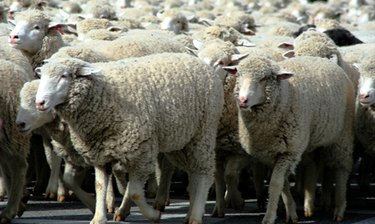Things You'll Need
Compost bin
Pitchfork or shovel
Earthworms
Carbon source such as leaves
Nitrogen source such as grass, manure or blood meal

Composting is an ancient tradition which reduces waste and converts it into reusable soil. While compost bins are often filled with food waste such as apple cores, egg shells and orange peels, less obvious materials such as wool can also be composted. Wool compost is especially useful in gardening, as it has the ability to retain water while releasing nutrients to feed plants. If your wool is pure wool with no synthetic materials, it can be composted in moderate amounts.
Step 1
Place your compost bin outdoors, if possible.
Video of the Day
Step 2
Add small amounts of wool and other materials to your compost bin. Fruit and vegetable food wastes are fine, but you should avoid adding bones, meats or oils to your bin, as they cause odors and attract vermin.
Step 3
Add carbon and nitrogen sources to your compost bin, in a 30:1 ratio of carbon to nitrogen. These elements are necessary to prevent odors and feed bacteria and fungi. Leaves can be used as a carbon source, and fresh grass, manure and blood meal can be used for nitrogen sources.
Step 4
Add earthworms to the mix, if you wish. They can help break down your compost material into small particles that are easier for bacteria and fungi to digest, which helps them multiply more quickly and generate more heat in your pile. Breaking down your pile by chopping it up with a shovel has the same effect.
Step 5
Keep your compost pile at a temperature of 90 to 140 degrees Fahrenheit, which you can measure by sticking a long-stemmed thermometer into your pile. Temperatures will be higher inside the bin than outside.
Step 6
Aerate your compost pile by turning it with a shovel or pitchfork at least once a month to provide oxygen and prevent odors. This is especially important when composting wool, since the material emits methyl sulfides and other offensive compounds when breaking down. Turning your compost will also regulate temperature levels.
Step 7
Squeeze your compost at least once a month to assess moisture level. An ideal compost mix will have the moisture level of a wrung out sponge. If the pile is too dry, it can emit odors and slow decomposition. Add some water in this case. If the pile is too wet, turn it with a shovel. If that does not solve the problem, add dry materials such as leaves.
Step 8
Keep checking on and maintaining your compost pile. When the contents resemble soil, it is ready to use in your garden.
Video of the Day